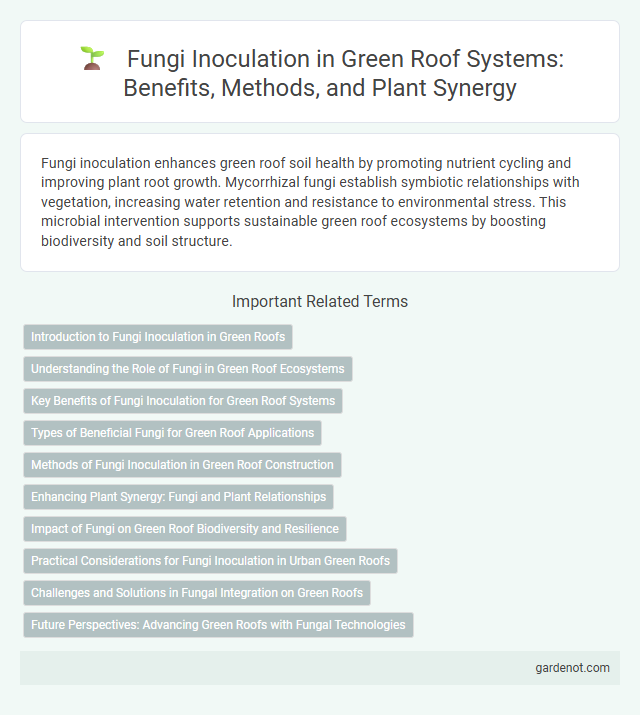Fungi inoculation enhances green roof soil health by promoting nutrient cycling and improving plant root growth. Mycorrhizal fungi establish symbiotic relationships with vegetation, increasing water retention and resistance to environmental stress. This microbial intervention supports sustainable green roof ecosystems by boosting biodiversity and soil structure.
Introduction to Fungi Inoculation in Green Roofs
Fungi inoculation in green roofs involves introducing beneficial mycorrhizal fungi to enhance plant root systems and improve nutrient uptake. These fungi form symbiotic relationships with plant roots, increasing soil structure stability and water retention in rooftop substrates. Incorporating fungi inoculation promotes healthier vegetation growth and boosts the overall resilience and sustainability of green roof ecosystems.
Understanding the Role of Fungi in Green Roof Ecosystems
Fungi inoculation enhances green roof ecosystems by improving soil structure and nutrient cycling through symbiotic mycorrhizal relationships with plant roots. These fungi increase water retention and promote plant health by facilitating nutrient absorption, which is critical in the shallow substrates typical of green roofs. Incorporating diverse fungal species supports resilient, sustainable vegetation and contributes to the overall ecological balance of green roof systems.
Key Benefits of Fungi Inoculation for Green Roof Systems
Fungi inoculation enhances green roof systems by improving soil structure and nutrient availability through mycorrhizal networks, which increase plant root absorption efficiency. It promotes robust plant growth and resilience by facilitating water retention and stress tolerance in drought-prone environments. This biological enhancement reduces the need for chemical fertilizers, supporting sustainable and eco-friendly green roof maintenance.
Types of Beneficial Fungi for Green Roof Applications
Mycorrhizal fungi, such as arbuscular mycorrhizal fungi (AMF) and ectomycorrhizal fungi, improve nutrient uptake and water absorption in green roof substrates, enhancing plant health and drought resistance. Saprophytic fungi, including species like Trichoderma and Penicillium, contribute to organic matter decomposition and nutrient cycling, promoting soil fertility on green roofs. Endophytic fungi establish symbiotic relationships with green roof plants, increasing stress tolerance and disease resistance, which is critical for maintaining vegetation in extreme rooftop environments.
Methods of Fungi Inoculation in Green Roof Construction
Fungi inoculation in green roof construction is primarily achieved through spore suspension spraying, mycelium-embedded substrates, and biochar carriers enriched with fungal cultures. These methods enhance mycorrhizal colonization, promoting plant nutrient uptake, moisture retention, and soil structure improvement. Selecting native mycorrhizal fungi tailored to local green roof flora optimizes symbiotic effectiveness and ecosystem resilience.
Enhancing Plant Synergy: Fungi and Plant Relationships
Fungi inoculation on green roofs significantly enhances plant synergy by establishing mycorrhizal networks that improve nutrient and water uptake for vegetation. These symbiotic relationships increase plant resilience to environmental stressors and promote healthier root development, leading to more robust and sustainable green roof ecosystems. Integrating fungi inoculants optimizes soil microbiome diversity, directly supporting plant growth and ecosystem stability.
Impact of Fungi on Green Roof Biodiversity and Resilience
Fungi inoculation enhances green roof biodiversity by promoting symbiotic relationships with native plants, increasing nutrient cycling and soil health. Mycorrhizal fungi improve plant water retention and resistance to environmental stressors, contributing to greater resilience of green roof ecosystems. This biological augmentation supports habitat complexity, fostering diverse microbial communities essential for long-term sustainability.
Practical Considerations for Fungi Inoculation in Urban Green Roofs
Implementing fungi inoculation in urban green roofs requires selecting mycorrhizal species compatible with the local plant communities and soil conditions to enhance nutrient uptake and stress tolerance. Proper timing of inoculation, typically during planting or early growth stages, maximizes fungal colonization and symbiotic benefits. Maintaining adequate soil moisture and organic matter supports fungal establishment and long-term green roof ecosystem health.
Challenges and Solutions in Fungal Integration on Green Roofs
Fungi inoculation on green roofs faces challenges such as substrate suitability, moisture retention, and maintaining appropriate pH levels for fungal colonization. Solutions involve selecting compatible fungal species, optimizing substrate composition with organic matter to enhance water retention, and monitoring environmental parameters to support fungal growth. Implementing controlled inoculation techniques and regularly assessing microbial community dynamics further improves fungal integration and promotes sustainable green roof ecosystems.
Future Perspectives: Advancing Green Roofs with Fungal Technologies
Fungi inoculation on green roofs shows promising future perspectives by enhancing soil nutrient cycling and plant health through symbiotic mycorrhizal relationships. Advancements in fungal strain selection and bioinoculant formulations aim to improve drought resilience and pollutant degradation on urban rooftops. Integrating fungal technologies into green roof design can significantly boost ecosystem services and sustainability in urban environments.
Fungi inoculation Infographic

 gardenot.com
gardenot.com